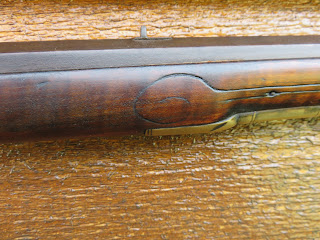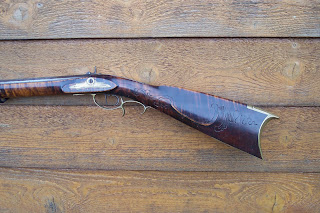By Paul Skinner
Andrew Phlem (Phlemmin, Phlemin) Mcdermit (Mcdermitt, Mcdermot, McDermott, McDermitt) is documented to have been born on July 5, 1827 to James Mcdermit (born in Big Beaver, Pennsylvania) and Susanannah Peck. There are conflicting records of his birthdate, ranging from 1827-1832. His parents were living in Mason County, Virginia by 1820, which is where Andrew married his wife Mary Shirly in 1852. His paternal grandparents were Daniel Mcdermit and Sarah Fleming. His maternal grandparents were Peter Peck and Mary from Lancaster County, Pennsylvania. Peter Peck was a Revolutionary War veteran.Included is an original Bible page from Andrew Phlem McDermit's father's Bible.
Click Pictures for Large Image
Andrew had a brother, John, who named his son after Andrew. Andrew’s nephew was born in 1852 and opened a blacksmith shop.
Included is a photo of the Blacksmith shop with his nephew, Andrew Phlem Mcdermit.
In the 1850 and 1860 census, Andrew P. Mcdermit was listed as a gunsmith. His gunsmith profession at the onset of such an active service makes me wonder if he would have made his guns that he took into so many battles including Gettysburg. In 1865 in a tax list of Point Pleasant, he is listed as a dentist/druggist and later in 1870 and 1880 (Gallia, Ohio), he continues as a dentist . It would appear as though most of his guns were made prior to the Civil War (1850-1862).
Signed A P McDermit
There was a draft registration originating from Putnam County, West Virginia, dated July 1, 1863. At this time he is listed as age 34 and working as a dentist. This date is in conflict with the military record of service of May 1, 1862 to May 9, 1865. On this document he is listed as 25 years old at the time of entering service as a private in 1862 with the honored Ohio 61st regiment, which later was consolidated as a veteran corp known as the Ohio 82nd Regiment. It is a true honor to view the many battles including Gettysburg that Andrew P. Mcdermit was actively involved. I have pictures of the monuments that were placed to honor the men such as Andrew P. Mcdermit for their extremely active service in the Ohio 61st Regiment. These monuments can be viewed at Gettysburg, Pennsylvania. I have a step by step description of Andrew's involvement during the Battle of Gettysburg. I also have the extensive list of all the battles in which Andrew P. Mcdermit was involved. He was a true American Hero.
The 61st Ohio Infantry was organized by companies from various parts of Ohio in April and May 1862. It reenlisted as a veteran regiment from January to April 1864, was consolidated with the 82d Ohio Infantry on March 31, 1865, and was mustered out July 24, 1865.
From the rear:
Principal engagements
—-
Freeman’s Ford Resaca
Warrenton Sulphur Springs New Hope Church
Groveton Culp’s Farm
Chancellorsville Peach Tree Creek
Gettysburg Atlanta
Wauhatchie Sandersville
Mission Ridge Monteith Swamp
Relief of Knoxville Savannah,
Bentonville
Andrew P. Mcdermit's step by step involvement at the Battle of Gettysburg.
The 61st Ohio Infantry
—-
On arriving from Emmittsburg about one o’clock p.m., July 1, 1863, was deployed as skirmish line in advance of its Brigade and moved towards Oak Hill. Later it supported a section of Dilger’s Battery, and engaged the enemy on this ground. After an obstinate contest it withdrew with the 11th Corps to Cemetery Hill. On the evening of July 2, it moved to the assistance of the 12th Corps on Culp’s Hill, and returning lay on Cemetery Hill during the remainder of the battle.
Andrew Phlem Mcdermit died in 1899.
Special Thanks to Paul Skinner for sharing his research & photos.
























































































